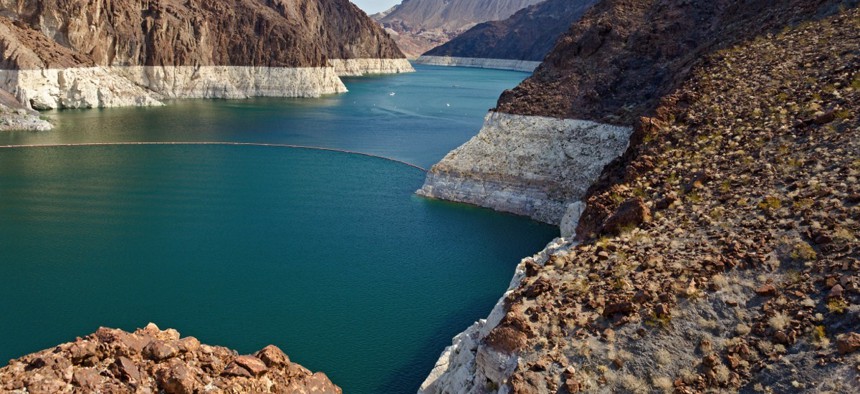Water Demand Outpaces Supply in Colorado River Basin Communities

The Colorado River's Lake Mead reservoir behind Hoover Dam. Marco Rubino / Shutterstock.com

Connecting state and local government leaders
A new Bureau of Reclamation report offers municipalities a number of innovative ways to conserve and reuse the strained natural resource.
Water conservation programs and policies must be expanded by local stakeholders in the Colorado River Basin for the water supply to meet increasing demand, according to a U.S. Bureau of Reclamation report released last week.
The 1,450-mile river spans seven states in the American West, provides water to 36 million people, irrigates 15 percent of U.S. crops, generates $26 billion in recreation and tourism revenue and helps support around 234,000 jobs.
But unsustainable consumption and a 14-year drought, coupled with expected population growth among Colorado River Basin communities, necessitated the launch of the Department of the Interior’s Moving Forward effort in 2013 to address the water supply-demand imbalance.
“We have an array of examples from successful conservation efforts, and a further, recent example from California’s strong drought response, that significant, proactive steps are possible,” Matt Rice, American Rivers’ director of Colorado Basin Programs, said in a statement. “Government, communities, agriculture and individuals all have a role to play in advancing innovative solutions that increase water efficiency.”
Outreach and partnerships are key to attracting broad support for innovations, per the report, and new funding and technical assistance programs tapping into multiple sources lead to rapid, efficient and creative water use efficiency measures and projects.
The report cited the Natural Resources Conservation Service’s Regional Conservation Partnership Program and Reclamation’s WaterSMART Program for providing cost-share funding—a stable, long-term revenue stream for completing goals or projects.
Seven types of water conservation programs were identified in the report as being used broadly throughout major metropolitan areas: metering and billing; public education and community outreach; water-loss characterization and reduction practices; residential indoor practices; commercial, industrial, and institutional practices; outdoor landscaping practices; and reuse.
Program outcomes varied dramatically between the innovation case studies in the report.
Water budget-based tiered rates weren’t a one-size-fits-all approach:
Water saving varies for each agency. Agency estimates of water savings range from 4 percent to 20 percent for participants. The University of California, Riverside, completed an analysis of [Eastern Municipal Water District] tiered rates that estimated a 15 percent water savings for residential customers.
While home water reports delivered to customers in Collins, Colorado, made them more conscious of how their water use compared to what was “typical”:
Utilities found Home Water Reports to be a cost-effective method to reduce a customer’s total water use. After delivery of two reports, water savings was estimated at 1.6 percent or 3.2 million gallons.
Denver’s Water Pipe Replacement Program has proved a “proactive” approach to repairing pipes before they break, where their old system was reactive:
The new, proactive approach has substantially reduced the number of breaks in pipe mains and the problems caused by breaks, including the loss of water. So far there is not a measurable metric available to estimate the reduction in pipe breaks using the proactive method. Therefore a water savings estimate is not possible. There is an overall potential to save several thousand acre-feet per year through reducing water system losses. While the primary purpose of the proactive approach is to reduce the inconveniences caused by main breaks, it is expected to save more water per dollar spent on replacements compared to the traditional pipe replacement approach.
Other case studies looked at a range of desert-friendly landscaping, conservation outreach and recyclable water programs.
Whatever innovative methods local governments turn to improve water supply, multi-agency efforts are encourage in the report.
"The impacts of the ongoing drought are widespread and are currently being addressed at the local and regional levels,” Bureau of Reclamation Lower Colorado Regional Director Terry Fulp said in a statement. “Looking ahead to the longer-term challenges facing the Basin documented in the 2012 Study, it is clear that these challenges must be tackled collaboratively involving all sectors of use."

NEXT STORY: Texas Governor Signals Intent to Block Municipal Rules on Fracking





